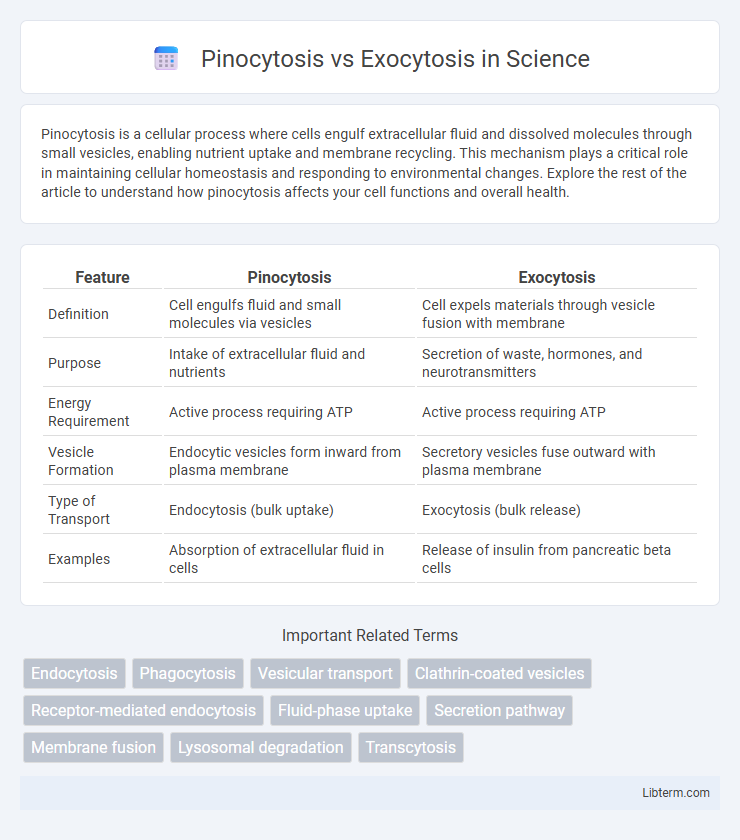Pinocytosis is a cellular process where cells engulf extracellular fluid and dissolved molecules through small vesicles, enabling nutrient uptake and membrane recycling. This mechanism plays a critical role in maintaining cellular homeostasis and responding to environmental changes. Explore the rest of the article to understand how pinocytosis affects your cell functions and overall health.
Table of Comparison
| Feature | Pinocytosis | Exocytosis |
|---|---|---|
| Definition | Cell engulfs fluid and small molecules via vesicles | Cell expels materials through vesicle fusion with membrane |
| Purpose | Intake of extracellular fluid and nutrients | Secretion of waste, hormones, and neurotransmitters |
| Energy Requirement | Active process requiring ATP | Active process requiring ATP |
| Vesicle Formation | Endocytic vesicles form inward from plasma membrane | Secretory vesicles fuse outward with plasma membrane |
| Type of Transport | Endocytosis (bulk uptake) | Exocytosis (bulk release) |
| Examples | Absorption of extracellular fluid in cells | Release of insulin from pancreatic beta cells |
Introduction to Cellular Transport Mechanisms
Cellular transport mechanisms include pinocytosis and exocytosis, which regulate the movement of materials across the cell membrane. Pinocytosis involves the ingestion of extracellular fluid and dissolved solutes through small vesicles, enabling nutrient uptake and cellular hydration. Exocytosis facilitates the release of intracellular substances, such as neurotransmitters and waste products, by vesicle fusion with the plasma membrane, maintaining cellular homeostasis.
Defining Pinocytosis: The Cell Drinking Process
Pinocytosis is a form of endocytosis where cells engulf extracellular fluid and dissolved solutes by invaginating their plasma membrane, forming vesicles to internalize nutrients and signaling molecules. This cell drinking process enables the uptake of small particles and fluid, crucial for cellular nutrient acquisition and homeostasis. In contrast, exocytosis involves the expulsion of materials from the cell through vesicles fusing with the plasma membrane, facilitating waste removal and secretion of biomolecules.
Understanding Exocytosis: Cellular Export Pathways
Exocytosis is a cellular export pathway where vesicles containing molecules fuse with the plasma membrane to release their contents outside the cell, playing a crucial role in processes like hormone secretion, neurotransmitter release, and waste removal. This mechanism ensures precise regulation of cellular communication and membrane composition by transporting proteins, lipids, and signaling molecules from the Golgi apparatus to the cell exterior. In contrast, pinocytosis involves the non-specific uptake of extracellular fluid and solutes through vesicle formation, highlighting distinct roles in cellular import versus export dynamics.
Pinocytosis vs Exocytosis: Key Functional Differences
Pinocytosis involves the cellular ingestion of extracellular fluid and dissolved solutes through vesicle formation, enabling nutrient uptake and cellular hydration. Exocytosis facilitates the expulsion of intracellular waste products or secretion of substances such as hormones and neurotransmitters by vesicle fusion with the plasma membrane. Key functional differences include pinocytosis primarily mediating intake and internalization processes, whereas exocytosis governs export and communication functions within cellular activities.
Biological Significance of Pinocytosis
Pinocytosis is a cellular process that facilitates the continuous intake of extracellular fluids and dissolved substances, playing a crucial role in nutrient absorption and cellular homeostasis. This mechanism enables cells to regulate their internal environment by sampling and internalizing solutes, contributing to cell signaling and metabolism. Unlike exocytosis, which expels materials, pinocytosis ensures the dynamic exchange of fluids and molecules essential for cell survival and function.
Biological Roles of Exocytosis
Exocytosis plays a crucial role in cellular communication by facilitating the release of neurotransmitters and hormones into the extracellular space, enabling signal transmission between cells. It also maintains membrane integrity through the recycling of membrane components and removal of waste products. Furthermore, exocytosis supports immune responses by secreting antibodies and other defensive molecules necessary for pathogen neutralization.
Step-by-Step Process of Pinocytosis
Pinocytosis begins with the invagination of the plasma membrane to form a small vesicle that engulfs extracellular fluid and dissolved solutes. This vesicle pinches off internally and moves into the cytoplasm, where it fuses with early endosomes for sorting. Enzymatic processes within endosomes facilitate the breakdown or distribution of the internalized substances to various cellular destinations.
Mechanisms of Exocytosis in Cells
Exocytosis in cells involves the fusion of vesicles with the plasma membrane to release intracellular substances into the extracellular space, driven by SNARE proteins and intracellular calcium signals. The process includes vesicle transport along the cytoskeleton, tethering to the membrane, docking, and membrane fusion facilitated by synaptotagmin and syntaxin complexes. This mechanism contrasts with pinocytosis, where cells internalize extracellular fluid via membrane invagination, highlighting exocytosis's role in secretion and membrane recycling.
Comparative Table: Pinocytosis vs Exocytosis
Pinocytosis involves the cellular uptake of extracellular fluids and small molecules through vesicle formation, whereas exocytosis facilitates the release of intracellular substances like hormones and waste by vesicle fusion with the plasma membrane. Key differences include pinocytosis being an endocytic process consuming extracellular material, contrasted with exocytosis as a secretory mechanism expelling contents. Both processes are vital for maintaining cellular homeostasis, with pinocytosis enabling nutrient intake and exocytosis supporting communication and waste removal.
Applications and Implications in Medical Science
Pinocytosis facilitates targeted drug delivery by enabling cells to ingest extracellular fluids and solutes, improving the cellular uptake of therapeutics like nanoparticles and vaccines. Exocytosis plays a crucial role in neurotransmitter release and hormone secretion, impacting treatments for neurological disorders and endocrine diseases. Understanding these processes enhances gene therapy, immunotherapy, and controlled drug release, advancing personalized medicine and diagnostic techniques.
Pinocytosis Infographic

 libterm.com
libterm.com